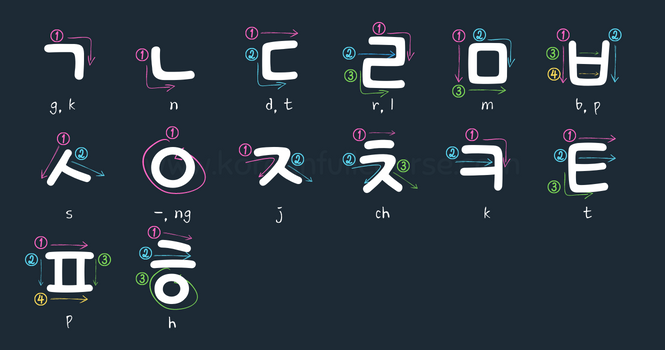Basic Consonants in Korean
The Korean text pronunciation feature (🔊) is only available for Chrome, Edge, Safari, and Opera browsers.
14 Basic Consonants
In this lesson, you will learn 14 out of 19 Korean consonants. You will learn the other 5 consonants in the next lesson.
ㄱ
k, g
ㄴ
n
ㄷ
t, d
ㄹ
r, l
ㅁ
m
ㅂ
p, b
ㅅ
s, sh
ㅇ
-, ng
ㅈ
j
ㅊ
ch
ㅋ
k
ㅌ
t
ㅍ
p
ㅎ
h
Here we have slightly changed the order of the consonants to make it easier for you to memorize them. Move your mouse over a letter to see how it's written or click on it to learn how to pronounce it.
ㄱ
k, g
ㅋ
k
ㄴ
n
ㄷ
t, d
ㅌ
t
ㄹ
r, l
ㅁ
m
ㅂ
p, b
ㅍ
p
ㅅ
s, sh
ㅇ
-, ng
ㅈ
j
ㅊ
ch
ㅎ
h
🔊 (Click on a letter to hear its sound.)
In Korean, the pronunciation of some consonants changes depending on their location within a word. In the upcoming lessons, you will learn all the rules for reading Korean.
For now, remember these simple rules:
When the consonants ㄱ, ㄷ, ㅂ are at the start or end of a word, they sound like 'k, t, p'. When they are between vowels or after letters ㄴ, ㄹ, ㅁ, ㅇ they sound like 'g, d, b'.
When the letter 'ㅇ' appears immediately before a vowel letter (not sound), it remains silent and is not pronounced. However, in all other cases, it is pronounced as 'ng' (just like 'ng' sound in the English word 'doing').
When the letter ㄹ is at the start of a word or between vowels, it sounds like 'r'. But if it is anywhere else in the word, it sounds like 'l'.
Rules of writing Korean letters
See how to write 14 basic Korean consonants.
There are two rules that are not mandatory, but it is recommended to follow when writing Korean letters.
1. Horizontal strokes should go from left to right →
2. Vertical strokes should go from top to bottom ↓

Exercises
Quick reference (click to open)
Vowels: a, e, i, o, u
Consonants: b, c, d, f, g, h, j
Syllable: Bra-zil (2 syllables), Ar-gen-ti-na (4), In-di-a (3), Viet-nam (2), thin-king (2), beau-ti-ful (3), good (1)
Batchim: is a final consonant in a syllable. → Bra-zil (batchim: 'l'), Ar-gen-ti-na (batchims: 'r' and 'n'), In-di-a ('n'), Viet-nam ('t', 'm')
Romanization: is a conversion of text (not pronunciation ! ) from different writing system (Korean, Arabic, Russian, etc.) to the Roman (Latin) alphabet.
IPA: is an alphabetic system of phonetic (pronunciation) notation.
Noun: road, user, sister, table, sky
Pronoun: I, my, we, you, they, her
Verb: to go, to study, to think, to feel
Adjective: cold, kind, hungry, curious, expensive
Adverb: quickly, nicely, never, exactly, urgently
Preposition: from, to, on, in, with, till
Conjuction: and, because, if, but, while
Declarative sentence: I learn Korean.
Interrogative sentence: Do you learn Korean?
Imperative sentence: You must learn Korean!
Exclamative sentence: Wow, you learn Korean!
Verb / Adj. stem in Korean: part of a verb or adj. which is left after removing the last syllable -다 ( e.g. 가다 → 가, 예쁘다 → 예쁘, 듣다 → 듣 ).



